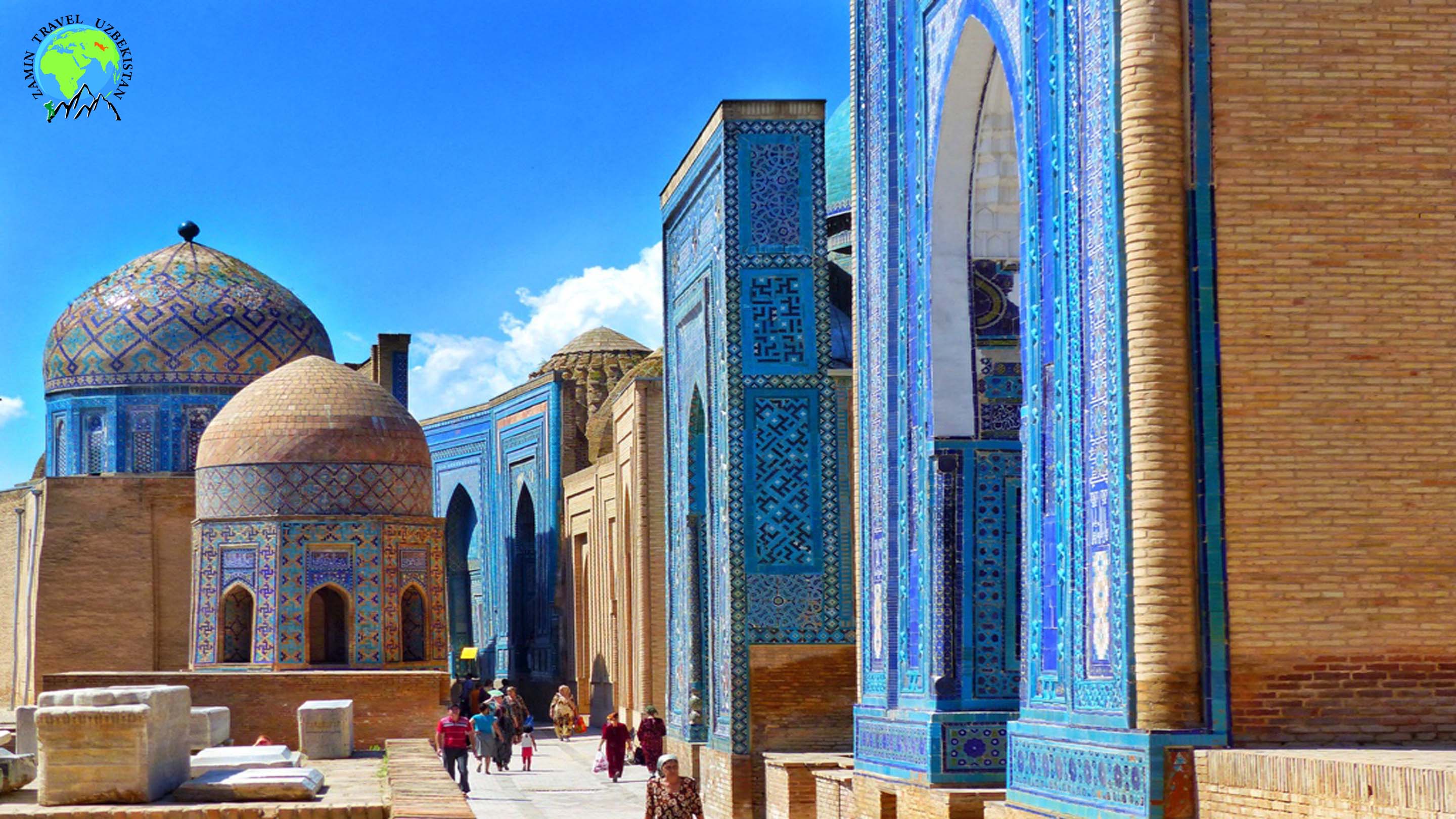


Shahi-Zinda necropolis
(World Heritage)
The Shahi-Zinda necropolis is one of the graphically most impressive architectural monuments from Amir Timur's times in Samarkand. At the end of the 9th century, the necropolis was on the outskirts of Afrosiab, near the Shrine of the Saints Kusam ibn Abbas, a cousin of the Prophet Mohammed. Other mausoleums continued to be built near the sacred site until the mid-15th century. Kusam ibn Abbas was killed in a battle in Samarkand in the 7th century and was buried on the southeast of Afrosiab. But legend has it that he was not killed, but went through a well underground to return on a certain day. So it became Shahi-Zinda, Kusam's nickname is synonymous with "The Living King." In the later period, the entire complex was named after it. Of the 14 existing mausoleums in the complex, the tomb of Kusam ibn Abbas is the oldest. The portal at the entrance to the necropolis was built by Ulugbek in 1435 on behalf of his younger son Abdulaziz. This was the last building in the complex. The inscription on the portal can still be read today: “The majestic building was built by Abdulaziz Khan, the son of Ulugbek Guragan, the son of Amir Timur's son Shahrukhs erected. "
Starting from the entrance portal, there are stone stairs up to the old mausoleums. The upper group of buildings is laid out around the shrine of Kusam ibn Abbas, built before Timur's reign. The mausoleum over the tomb of Kusam ibn Abbas was built in the 11th century; In the following centuries it was rebuilt several times. In 1334, next to the tomb, a ziyoratkhona: a room for prayer was set up. According to the order of Amir Timur, a new dome was erected over the mausoleum. The facility was supplemented with a Chillyakhona: a room for 40 days of fasting and a room for storing cult objects. Behind the wooden lattice in the crypt is a magnificent multi-tier tombstone that was built in the 1370s. It is decorated with majolica with fine botanical patterns, with gold. Throughout the year, numerous pilgrims visit the mausoleum of Kusam ibn Abbas, which has been considered a holy Muslim shrine for centuries.
Since this part of Afrosiab was a densely built area in the 10th century, the mausoleums formed a kind of narrow street. Next to the Kusam ibn Abbas complex are two arched mausoleums that were built in the mid-14th century. Their portals are covered with light and dark blue glazed bricks. Haji Ahmad was buried in one of these mausoleums. The only other known is that they were built by the architect Ali Nesefi.
For a Muslim, it was an honor to be buried near the Holy Sepulcher, and soon several mausoleums were erected for the relatives of Amir Timur. In the upper part of the mausoleums, the closest place to the holy shrine, is the mausoleum of Tuman Aka, the wife of Timur. It is decorated with polychrome mosaic and its walls contain paintings of elegant flowers and stems; the inside of the dome looks like a blue vault of sky with gold stars. The portal also contains the name of the architect: Sheikh Mohammed Ibn Hadschi Bandgira al-Tugri of Tebriz.
Among the mausoleums in the middle group is the beautiful dome of the mausoleum of Emir Burunduk, commander in chief of Timur's army. There is also an unnamed mausoleum with an unusual layout, an octahedron. Turkan Aka, one of Timur's sisters, built the mausoleum for herself and for her daughter Shadi Mulk Aka, who died very young. This mausoleum is one of the most beautiful in the complex. It has beautiful stucco carvings and its portal is covered with majolica decorations. The following touching inscription still stands above the entrance to the mausoleum: “This is the garden where the treasure of happiness was buried. This is the tomb where a precious pearl was lost
gone and where the one that was shaped like a cypress found refuge. "
The mausoleums of the lower group of the complex are at the foot of the stairs. The most notable of these is the one with two domes. It is known for its large and at the same time fine proportions. For a long time it was believed that the mausoleum contained the remains of the famous astronomer Qadi Zada-al-Rumi. However, the examination of the tomb has shown that they are the graves of women. Tradition ascribes these graves as Amir Timur's wet nurse and her daughter. Although the buildings of the Shahi-Zinda mausoleum were built at different times, they form one of the most fascinating architectural ensembles in Central Asia, while the artistic furnishings of the tombs give a clear idea of the developments in oriental decorative styles. The mausoleum from 1372 is considered to be one of the oldest architectural monuments from the time of Amir Timur's rule in Samarkand. Opposite the Shadi Mulk Aka mausoleum is the mausoleum of Shirin Bika Aka, another of Timur's sisters. For the first time ever, its walls were covered with carved mosaic. The interior is not typical of a mausoleum: there are windows under the dome that let the light in. The window openings with "Panjara grilles" were decorated with pieces of stained glass to create an extraordinary lighting effect. The tiles of the wall panels were covered with very fine gold tracery; the space above the panels still contains the remains of the original painting with paradisiacal trees and birds.